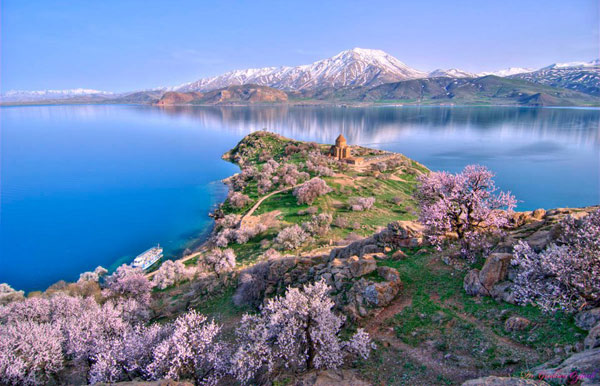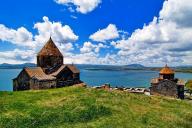-
Lake Sevan is the largest lake in Armenia and the Caucasus region. It is one of the largest fresh-water high-altitude lakes in the world. Maximum depth of Sevan is 80 m, maximum length – 70 km, maximum width – 55 km, circumference – 230 km. The maximum temperature is registered in July-August (+28 C), the minimum in January-February. The average humidity in winter in Minor Sevan is 70-75%, in Major Sevan – 80-85%; in summer - 65% in Minor Sevan and 75% in Major Sevan.
There are numerous beaches along the entire lake shore. The most popular of them is a 2.5 kilometre stretch on the northern shore, extending northwest from the peninsula. Resorts include Harsnaqar Hotel, Best Western Bohemian Resort, and numerous smaller facilities. Activities include swimming, sunbathing, jet skiing, windsurfing, and sailing. The area also includes numerous campgrounds and picnic areas for daytime use.
A less developed beach destination stretches along the eastern shore from Tsovagyugh to Shorzha, with numerous small cabins at Shorzha. The Avan Marak Tsapatagh Hotel, a Tufenkian Heritage Hotel, is a luxury resort on the undeveloped southeastern shore of the lake near Tsapatagh.
The most famous cultural monument is the Sevanavank monastery near the town of Sevan at the northwestern shore. Initially the monastery was located on an island, but the fall of the water level turned it into a peninsula. Another monastery at the western shore is Hayravank Monastery, and further south, in the village of Noraduz, there is a field of khachkars, a cemetery with approximately 900 khachkars of different styles. Additional khachkars are found at Nerk'in Getashen on the south coast. When the water level fell, many archaeological artifacts were found, 2000 years of age and older (some as old as the early Bronze Age). Most of them are now displayed in Yerevan.
More information about hotels : http://www.booking.com/city/am/sevan.html
Sightseengs neraby :
Sevan Botanical Park The originality of the park is the fact that it is on the altitude of 2000 meters above sea level and it has about 420 species of plants.
Mashtotsner Monastery
The monastery was built in 1984 near the former Sevan-Dilijan highway. Tourists rarely vist Mashtotsneri Monastery which the locals consider a sanctuary due to healing qualities of a very cold spring.
Metsep Mountain
The site is interesting due to its position: from the height of 2200 meters one can see Sevan town and Lake Sevan outline with its picturesque color diversity, and at fair weather also Ararat and Aragats mountains.
Sevan Cathedral
Construction works started in 2006 and are still in process (by the sponsorship of French-Armenian benefactors Sargis Petoyan and Alen Manukyan).
Ropeway (Akhtamar Hotel Area)
Sevan skiing center is located on picturesque slopes of Mashtotsner and Bekarner mountains where fans of winter sports are offered wonderful conditions matching international standards. Downhill skiers will find here all conveniences to enjoy their favorite sport.
The 1130 meter long ropeway will take tourists to the top of the mountain with an enchanting view of Lake Sevan. The ropeway capacity is 800 people in an hour. The skiing center has cafes and a bar where one can get tasty dishes for pleasantly surprising prices.


 Sevan-Peninsula.jpg600 x 386 - 81K
Sevan-Peninsula.jpg600 x 386 - 81K -
Sevanavank Monastery
Sevanavank Monastery is located in Gegharkunik region, which is popular in Armenia due to its possession of the blue pearl of Armenians, Lake Sevan. There are two churches on the peninsula of Sevan. These two churches were built in 874 AD and together form the Sevanavank Monastery.
According to an inscription found in the territory, the monastery was built by Armenian princess Mariam, daughter of Ashot I, who later became the king of Armenia and the founder of Bagratuni dynasty. Sevanavank is one of the 30 churches that Princess Mariam vowed to build in the memory of her husband. King Ashot I, in his turn, presented six villages and gardens in the territory of today’s Garni and Yerevan to the monastery.
However, the peninsula was a religious center even centuries before the construction of Sevanavank Monastery churches. Surb Harutyun Church was built by Gregory the Illuminator, the founder of the Armenian Apostolic Church. It is said that the church was ruined during an earthquake in 995. Even before Armenia’s adoption of Christianity as a state religion there was a small pagan temple on the island of Sevan.
It’s one of the few monasteries in Armenia that work for religious purposes. There are benches in front of the churches, where tourists can enjoy a stunning scene to Big and Little Sevan. The area around the churches is the only place where you can sit on a bench and watch at the colors of the lake, which are changeable and depend on the weather and the time of the day.
It’s important to mention that there is a special dress-code. Although the monastery is situated very close to holiday resorts, it’s forbidden to enter the church dressed in swimsuit, very short skirt, and so on. Your legs and shoulders must be covered appropriately.
Sevanavank Monastery is comprised of two churches, Surb Arakelots (Holy Apostles) and Surb Astvatsamayr (Holy Mother of God). The architecture of both churches is almost the same; they are made of black tuff in the form of a cross. Surb Astvatsamayr Church used to preserve the most important gifts to the monastery, including 200 manuscripts, 400 printed books, jewelry, crosses, and many other items. Some inscriptions dating back to the 9th century are still preserved on Surb Arakelots Church. The wooden door of this church is particularly worth attention, as it dates back to the 15th century and its carvings prove the brilliance of medieval Armenian art.
In 1930s both churches were closed down. Today, only Surb Arakelots Church is open to public.
The gavit was originally decorated with wooden columns with beautiful carvings. Some of the remains of this gavit can now be found in Yerevan State Museum of History and in State Hermitage Museum in St. Petersburg, Russia.
A narrow path leads to the ruins of another church-like construction, which was supposedly built later than the two churches.
Both churches were reconstructed in 1950s.
One of the most popular legends about Lake Sevan and Sevanavank Monastery is the following. During the battle between Armenians and Arabs, King Ashot Erkat was on the island. His soldiers were too few in comparison with the Arab army. Even with many monks and fishermen who joined their King, Arabs kept being more in number. Then Ashot Erkat spoke to one of his wise fishermen and asked for advice. The fisherman lived there for years and knew the peculiarities of weather well. He advised the King to attack the Arabs early in the morning when the sun just starts to rise. The King followed the advice, and led his soldiers in boats towards the Arabs. The sun was behind the Armenian forces and, therefore, blinded the Arabs. Armenians managed to win the battle, after which the lake was full of Arab soldiers. Because of the dead bodies and their uniforms, the lake looked black. Hence, the name Sevan.

 Sevanavanq5.jpg845 x 564 - 210K
Sevanavanq5.jpg845 x 564 - 210K
Howdy, Stranger!
It looks like you're new here. If you want to get involved, click one of these buttons!
Categories
- All Discussions21
- Countries
- ↳ Հայաստան/Armenia1
- ↳ USA2
- ↳ Russian Federation2
- ↳ Iran2
- ↳ France2
- ↳ Spain1
- ↳ Germany1
- ↳ Syria2
- General
- ↳ Հայկական խոհանոց/Armenian cuisine4
- ↳ Armenian Culture and History0
- ↳ Genocide2
- ↳ Christianity0
- ↳ Comeback Home0
- ↳ Մայրենի լեզու0
- ↳ News1
- ↳ Help Needed0
- Other
- ↳ Feedback0
- ↳ Rules1
- ↳ FAQ0
In this Discussion
- marianna.karapetyan June 2014

